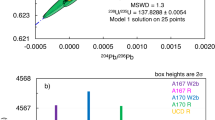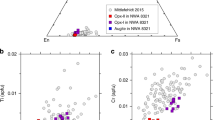Abstract
Angrite meteorites are thought to represent ancient basaltic igneous rocks that formed inward of Jupiter’s orbit on the basis of their isotopic parameters such as ε50Ti, ε54Cr and Δ17O in addition to Fe/Mn ratios of pyroxene. New bulk oxygen isotope measurements of nine angrites, and of olivine ‘xenocrysts’ and groundmass fractions from three quenched angrites, however, reveal clear isotopic disequilibrium, implying an impact melt origin. Groundmass fractions from Asuka 12209, Asuka 881371 and Northwest Africa 12320 quenched angrites demonstrate an average Δ17O value of −0.003 ± 0.020‰. Here, excluding the bulk value and all groundmass fractions of Northwest Africa 12320, which is contaminated by an impactor, we determine a new well constrained average Δ17O value for the angrite parent body (−0.066 ± 0.016‰). Microstructural investigations of Northwest Africa 12320 reveal the presence of both fully recrystallized and undeformed olivine xenocrysts, indicating that some xenocrysts underwent high-temperature processes. These results suggest that angrites bear signatures of impact-driven isotopic mixing, possibly in response to early giant planet migration. The evidence for impact mixing raises doubts about the utility of quenched angrites as a suitable Pb–Pb isotopic anchor, which in turn has consequences for accurately defining the timeline of other Solar System events.
This is a preview of subscription content, access via your institution
Access options
Access Nature and 54 other Nature Portfolio journals
Get Nature+, our best-value online-access subscription
$29.99 / 30 days
cancel any time
Subscribe to this journal
Receive 12 digital issues and online access to articles
$119.00 per year
only $9.92 per issue
Buy this article
- Purchase on Springer Link
- Instant access to full article PDF
Prices may be subject to local taxes which are calculated during checkout



Similar content being viewed by others
Data availability
All data generated or analysed during this study are included in either the article or its supplementary information.
References
Keil, K. Angrites, a small but diverse suite of ancient, silica-undersaturated volcanic–plutonic mafic meteorites, and the history of their parent asteroid. Geochemistry 72, 191–218 (2012).
Mittlefehldt, D. W., Killgore, M. & Lee, M. T. Petrology and geochemistry of D’Orbigny, geochemistry of Sahara 99555 and the origin of angrites. Meteorit. Planet. Sci. 37, 345–369 (2002).
Kruijer, T. S., Kleine, T. & Borg, L. E. The great isotopic dichotomy of the early Solar System. Nat. Astron. 4, 32–40 (2020).
Papike, J. J., Burger, P. V., Bell, A. S. & Shearer, C. K. Mn–Fe systematics in major planetary body reservoirs in the solar system and the positioning of the Angrite Parent Body: a crystal-chemical perspective. Am. Mineral. 102, 1759–1762 (2017).
Zhu, K. et al. Timing and origin of the Angrite Parent Body inferred from Cr isotopes. Astrophys. J. Lett. 887, L13 (2019).
Santos, A. R., Agee, C. B., Shearer, C. K., & McCubbin, F. M. Northwest Africa 8535 and Northwest Africa 10463: new insights into the angrite parent body. Abstr. Lun. Planet. Sci. Conf. 47, 2590 (2016).
Reger, P. M. et al. Chronology of the unique angrite Northwest Africa 10463. In Proc. 84th Annual Meeting of the Meteoritical Society 6235 (LPI, 2021).
Greenwood, R. C., Franchi, I. A., Jambon, A. & Buchanan, P. C. Widespread magma oceans on asteroidal bodies in the early Solar System. Nature 435, 916–918 (2005).
Greenwood, R. C., Burbine, T. H., Miller, M. F. & Franchi, I. A. Melting and differentiation of early-formed asteroids: the perspective from high precision oxygen isotope studies. Geochemistry 77, 1–43 (2017).
Scott, E. R. D. & Bottke, W. F. Impact histories of angrites, eucrites and their parent bodies. Meteorit. Planet. Sci. 46, 1878–1887 (2011).
Jambon, A. et al. Mineralogy and petrology of the angrite Northwest Africa 1296. Meteorit. Planet. Sci. 40, 361–375 (2005).
Jambon, A. et al. Petrology and mineralogy of the angrite Northwest Africa 1670. Meteorit. Planet. Sci. 43, 1783–1795 (2008).
Mikouchi, T., Hasegawa, H., Takenouchi, A., & Kagi, H. Olivine xenocrysts in Asuka-881371 revisited. Abstr. Lun. Planet. Sci. Conf. 46, 2065 (2015).
Mikouchi, T., et al. Mineralogy of olivine xenocrysts in Asuka 12009 angrite. Abstr. Lun. Planet. Sci. Conf. 48, 2206 (2017).
Miller, M. F., Franchi, I. A., Sexton, A. S. & Pillinger, C. T. High precision δ17O isotope measurements of oxygen from silicates and other oxides: method and applications. Rapid Commun. Mass Spectrom. 13, 1211–1217 (1999).
Starkey, N. A. et al. Triple oxygen isotopic composition of the high-3He/4He mantle. Geochim. Cosmochim. Acta 176, 227–238 (2016).
Trepmann, C. A., Renner, J. & Druiventak, A. Experimental deformation and recrystallization of olivine—processes and timescales of damage healing during postseismic relaxation at mantle depths. Solid Earth Discuss. 5, 463–524 (2013).
Janots, E. et al. Jiddat al Harasis 556: a howardite impact melt breccia with an H chondrite component. Meteorit. Planet. Sci. 47, 1558–1574 (2012).
Janots, E. et al. Jiddat al Harasis 422: a ureilite with an extremely high degree of shock melting. Meteorit. Planet. Sci. 46, 134–148 (2011).
Nazarov, M. A., Brandstätter, F., & Kurat, G. Angrite-like clasts from the Erevan howardite. Abstr. Lun. Planet. Sci. Conf. 26, 1033 (1995).
Cohen, B. A., Goodrich, C. A. & Keil, K. Feldspathic clast populations in polymict ureilites: stalking the missing basalts from the ureilite parent body. Geochim. Cosmochim. Acta 64, 4249–4266 (2004).
Kita, N. T. et al. Origin of ureilites, inferred from a SIMS oxygen isotopic and trace element study of clasts in the Dar al Gani polymict ureilites. Geochim. Cosmochim. Acta 68, 4213–4235 (2004).
Zhang, A. C. et al. Unique angrite-like fragments in a CH3 chondrite reveal a new basaltic planetesimal. Geochim. Cosmochim. Acta 275, 48–63 (2020).
Jambon, A., Baghdadi, B., & Barrat, J. A. Peridotitic angrites are chimerolites. Abstr. Lun. Planet. Sci. Conf. 43, 1758 (2012).
Sarafian, A. R. et al. Early accretion of water and volatile elements to the inner Solar System: evidence from angrites. Phil. Trans. R. Soc. 375, 20160209.
Deligny, C., Füri, E. & Deloule, E. Origin and timing of volatile delivery (N, H) to the angrite parent body: constraints from in situ analyses of melt inclusions. Geochim. Cosmochim. Acta 313, 243–256 (2021).
Greenwood, R. C., Burbine, T. H. & Franchi, I. A. Linking asteroids and meteorites to the primordial planetesimal population. Geochim. Cosmochim. Acta 277, 377–406 (2020).
Clayton, R. N., Mayeda, T. K., Goswami, J. N. & Olsen, E. J. Oxygen isotope studies of ordinary chondrites. Geochim. Cosmochim. Acta 55, 2317–2337 (1991).
Riches, A. J. V. et al. Rhenium–osmium isotope and highly-siderophile-element abundance systematics of angrite meteorites. Earth Planet. Sci. Lett. 353–354, 208–218 (2012).
Steenstra, E. S. et al. The effect of melt composition on metal–silicate partitioning of siderophile elements and constraints on core formation in the angrite parent body. Geochim. Cosmochim. Acta 212, 62–83 (2017).
Isa, J., Rubin, A. E. & Wasson, J. T. R-chondrite bulk-chemical compositions and diverse oxides: implications for parent-body processes. Geochim. Cosmochim. Acta 124, 131–151 (2014).
Morbidelli, A., Walsh, K. J., O’Brien, D. P., Minton, D. A. & Bottke, W. F. in Asteroids IV (eds Michel, P. et al.) 493–507 (Univ. Arizona Press, 2015).
Greenwood, R. C. et al. Oxygen isotopic evidence for accretion of Earth’s water before a high-energy Moon-forming giant impact. Sci. Adv. 4, eaao5928 (2018).
Qin, L. & Carlson, R. W. Nucleosynthetic isotope anomalies and their cosmochemical significance. Geochem. J. 50, 43–65 (2016).
Raymond, S. N., Izidoro, A. & Morbidelli, A. in Planetary Astrobiology (eds Meadows, V. et al.) 287–234 (Univ. Arizona Press, 2020).
Johnson, B. C., Walsh, K. J., Minton, D. A., Krot, A. N. & Levison, H. F. Timing of the formation and migration of giant planets as constrained by CB chondrites. Sci. Adv. 2, e1601658 (2016).
Walsh, K., Morbidelli, A., Raymond, S., O’Brien, D. P. & Mandell, A. M. A low mass for Mars from Jupiter’s early gas-driven migration. Nature 475, 206–209 (2011).
Connelly, J. N. et al. The absolute chronology and thermal processing of solids in the solar protoplanetary disk. Science 338, 651–655 (2012).
Wang, H. et al. Lifetime of the solar nebula constrained by meteorite paleomagnetism. Science 355, 623–627 (2017).
Brennecka, G. A. & Wadhwa, M. Uranium isotope compositions of the basaltic angrite meteorites and the chronological implications for the early Solar System. Proc. Natl Acad. Sci. USA 109, 9299–9303 (2012).
Clayton, R. N. & Mayeda, T. K. Oxygen isotope studies of achondrites. Geochim. Cosmochim. Acta 60, 1999–2017 (1996).
Miller, M. F. Isotopic fractionation and the quantification of 17O anomalies in the oxygen three-isotope system: an appraisal and geochemical significance. Geochim. Cosmochim. Acta 66, 1881–1889 (2002).
Martins, Z. et al. Amino acid composition, petrology, geochemistry, 14C terrestrial age and oxygen isotopes of the Shisr 033 CR chondrite. Meteorit. Planet. Sci. 42, 1581–1595 (2010).
Acknowledgements
K. Green and M. Higgins are thanked for their help in sample preparation. G. Degli-Alessandrini is thanked for her assistance with scanning electron microscopy and EBSD analyses. J. Malley is thanked for assisting with laser-fluorination work. G. Ensor is thanked for his help in procuring the NWA angrites. B.G.R.-S. was supported by an STFC studentship. M.A. and I.A.F. acknowledge support from STFC grant ST/T000228/1. Acquisition and analysis of A 12209 and A 881371 were supported by JSPS KAKENHI (JP19H01959 to A.Y., JP19H00726 and JP21K1845 to T.M.) and NIPR (research project KP307 to A.Y.), in collaboration with the Belgian Science Policy (Belspo) project BELAM for A 12209. V.D., S.G. and P.C. acknowledge the FWO-FNRS Excellence of Science (EOS) programme ET-HoME. V.D., L.P., S.G. and P.C. also acknowledge the Belspo project BELAM for past funding. V.D. thanks FRS-FNRS for support. S.G. and P.C. acknowledge the support of the VUB Strategic Programme.
Author information
Authors and Affiliations
Contributions
R.C.G., M.A. and I.A.F. devised the project. M.A. acquired the NWA samples while A samples were provided by A.Y. B.G.R.-S. and R.C.G. led the data acquisition and processing, supported by other authors. B.G.R.-S. produced the first draft of the paper. All authors participated in data interpretation and contributed during various stages of paper revision.
Corresponding author
Ethics declarations
Competing interests
The authors declare no competing interests.
Peer review
Peer review information
Nature Astronomy thanks Alexander Krot and the other, anonymous, reviewer(s) for their contribution to the peer review of this work.
Additional information
Publisher’s note Springer Nature remains neutral with regard to jurisdictional claims in published maps and institutional affiliations.
Supplementary information
Supplementary Information
Supplementary Discussion, Figs. 1–5 and Tables 1–3.
Rights and permissions
Springer Nature or its licensor (e.g. a society or other partner) holds exclusive rights to this article under a publishing agreement with the author(s) or other rightsholder(s); author self-archiving of the accepted manuscript version of this article is solely governed by the terms of such publishing agreement and applicable law.
About this article
Cite this article
Rider-Stokes, B.G., Greenwood, R.C., Anand, M. et al. Impact mixing among rocky planetesimals in the early Solar System from angrite oxygen isotopes. Nat Astron 7, 836–842 (2023). https://doi.org/10.1038/s41550-023-01968-0
Received:
Accepted:
Published:
Issue Date:
DOI: https://doi.org/10.1038/s41550-023-01968-0
This article is cited by
-
Antarctic meteorites threatened by climate warming
Nature Climate Change (2024)



